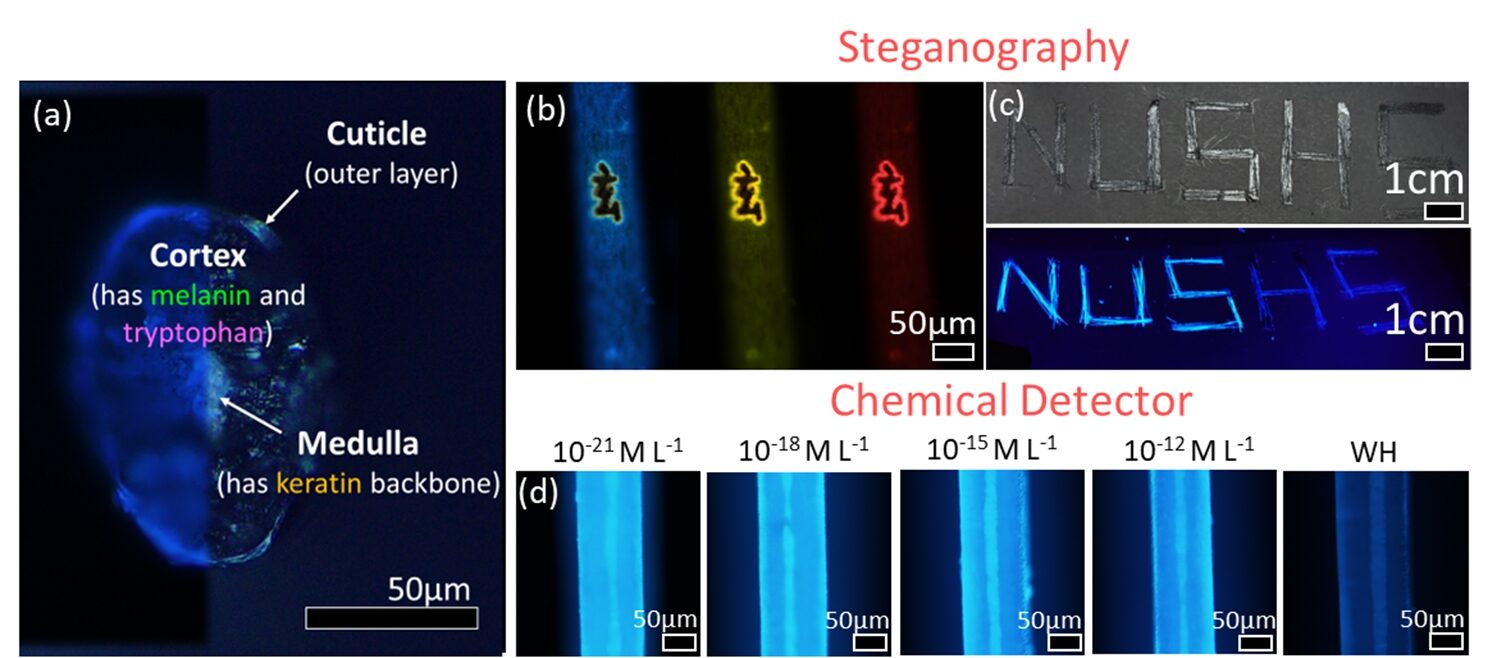Wonders of glowing human hair waste
June 30, 2023National University of Singapore (NUS) physicists transform human hair waste into a functional material by modifying its fluorescence properties with potential applications as both steganography material and an environmental pollutant sensor.
An average person sheds between 50 to 100 strands of hair per day. This may add up to a sizeable amount of waste which may take years to decompose into its natural form or end up in incinerators or waste streams and dumps, producing toxic fumes including ammonia and sulfur dioxide during the decomposition process. Landfills of hair waste can leach toxic chemicals into bodies of water, harming marine wildlife and potentially lead to algal blooms. Furthermore, human hair can be breeding grounds for pathogens, putting nearby communities at risk of disease outbreaks.
A research team led by Professor SOW Chorng-Haur from the Department of Physics, NUS, developed a heat treatment method that converts human hair waste into a functional material for potential steganographic and pollutant detection applications. The introduction of heat treatment changes the chemical nature of human hair and activates its fluorescence property. This allows information to be imprinted on or encoded using the material which becomes visible only under ultraviolet lighting conditions. The researchers also discovered that when subjected to heat treatment, white hair waste lacking melanin exhibits higher fluorescence levels when exposed to methylene blue, a type of chemical pollutant (see Figure). The findings are reported in the journal Advanced Photonics Research.
Steganography is the practice of concealing secret information within an ordinary message to avoid detection. One of the earliest evidence of the steganographic process dates back to ancient Greece around 400 BC. In the 21st century, steganography remains one of the most viable means of ensuring that secret messages are securely transmitted to the intended person. From the research findings, materials made from human hair waste could potentially be used for such purposes. The heat treatment can be applied at a macroscopic level on a batch of human hair waste using a hotplate to heat the materials. It can also be on a microscopic scale by focusing a laser beam onto a single spot on a strand of hair and then creating the required patterns to encode the message. When subjected to heating, the significant fluorescence enhancement is in part due to a change in the molecular structure of keratin-associated proteins in the hair.
Another potential application could involve the detection of methylene blue. Methylene blue is commonly used as a dye in the textile industry and is often discharged untreated into water bodies in developing nations. This dye can become a neurotoxin when interacted with some molecules such as serotonin reuptake inhibitors. Since white hair waste, after heat treatment, glows brightly under ultraviolet light when it comes into contact with methylene blue pollutants, this could open up an affordable way to detect them without using complicated and expensive analytical tools. The increase in fluorescence is attributed to the formation of tryptophan byproducts, such as N-formylkynurenine, through the photo-oxidation process and more electron-contributing pyrrolic nitrogen.
Prof Sow said, “As the human population increases, there will be increasing pressure to manage human hair waste. Instead of sending hair waste to the incinerator or landfill, it is worthwhile to repurpose hair waste for other potential applications.”
The research team is exploring using human hair waste for the development of a material for use as a steganographic ink and its potential application in a portable detector for methylene blue.

Figure: (a) Cross-section view of a human hair shows that it typically comprises of three regions, the medulla, the cortex and the cuticle. (b) Through a simple heating process, the chemical nature of human hair changes and this enhances its fluorescence capability allowing the formation of patterns. (c) Micro- and macroscopic messages can be hidden in plain sight using materials made from these human hairs. The words “NUS” are made from human hairs with heat treatment. (d) Visuals showing a strand of white hair immersed in different concentrations of methylene blue. Heat treatment of white human hair increases its chemical detection capabilities. When in contact with methylene blue pollutants, it glows brightly under ultraviolet light. [Credit: ADVANCED PHOTONICS RESEARCH]
Video clip showing the micro-styling of biofluorescence in human hair as sustainable and functional waste.
Reference
Sow MMG; Lim SX*; Zhang Z; Sow C H*, “Microstyling of Biofluorescence in Human Hair as Sustainable and Functional Waste” ADVANCED PHOTONICS RESEARCH DOI: 10.1002/adpr.202200161 Published: 2022.


